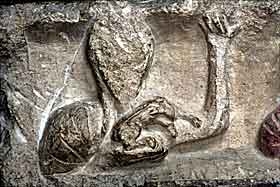- Home
- Society and power
- Deities and devotion
At least two craters, situles, or libation vases are sculpted in the round in scenes of heroic chapels. These large recipients suggest the practice of collective ceremonies and ritual libations near these sanctuaries.
In Protohistoric societies, religious beliefs and practices pervaded all social and domestic activities. Until the end of the Iron Age, the rural societies had very naturalistic conceptions of the relations between humans and deities.
The gods expressed themselves through signs transmitted by natural forces or through the behavior of animals. Augurs drawn from animal, or sometimes human, sacrifices allowed humans to respond to divinatory expectations. The Gauls of the Midi region (southern France), like those from more northern regions, were very respective of the religious duties and devotion they were expected to pay to their deities.
The Celts did not worship a unified and hierarchical pantheon. Rather, they expressed their devotion to common divinities of the local community or people. Individual devotion was expressed through modest votive offerings, and collective sacrifices were accompanied by libations over sacred areas. The divinities designated the places they would inhabit on the territory, and where humans would thus build and protect a sacred place (nemeton). Beginning in the first Iron Age, the development of grouped habitats and fortifications led to the emergence of modest places of worship intra muros.
Close-up of a praying figure offering a hare.

